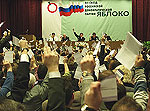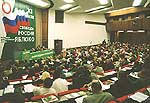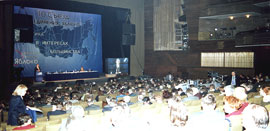Alexei Yablokov: Will another Chernobyl happen in the next 27 years?
 Blog by Alexei Yablokov, 21.04.2015
Blog by Alexei Yablokov, 21.04.2015
On the eve of 26 April – the International Day Commemorating Victims of Radiation Accidents and Catastrophes (in Russia since 2002 – the Day of Liquidators of Radiation Accidents and Commemoration of Victims These Accidents and Disasters”) – I was going to write that this ‘radiation year’ was marked by unprecedented Russian nuclear (military and energy) costs (comparable with all [Russia’s] national reserves), and irresponsible Russian nuclear blackmail which astonished and arouse serious concern in the world. However, yesterday I found the most detailed and serious statistical analysis of nuclear accidents and disasters which was published in a solid edition and I decided first of all to draw the attention of the mankind to an important conclusion of the Swiss-Danish team of researchers – about a 50 per cent probability of another disaster comparable with that in Chernobyl which may happen in the next 27 years.
This conclusion comes from a mathematical analysis of the most comprehensive list of the world’s atomic radiation accidents for the period 1946 – 2014 which was compiled by the authors. (It turns out that there were as many as 174 of such disasters). The researchers distinguish “ordinary” accidents related to radiation leakage (here they considered the accidents causing economic losses of over USD 50,000), and 15 catastrophic accidents, such as the Dragon Kings (a term used in Western literature since 1999 to refer to events repeatedly coming out of the general series). The analysis demonstrates that in general radiation accidents and disasters have been taking place less frequently, but their damage have increased. The authors calculated and the “costs” of the Fukushima disaster (USD 166 billion by 2015), and the “costs” of the Chernobyl disaster (USD 32 billion). According to my calculations (based on official estimates of Ukraine, Belarus and Russia), the “cost” of Chernobyl amounts to at least USD 500 billion. However, if 80 per cent of Fukushima radionuclides had not been blown away by the wind to the east and remained in Japan, the damages from Fukushima would have surpass Chernobyl by manyfold. Another conclusion of the authors, which immediately attracted the attention of specialists was that the international scale of radiation accidents, proposed by the IAEA and widely used in the world was not accurate enough.
Returning to the conclusion that the probability of a large nuclear disaster – and “forewarned is forearmed”, and “he who has ears, let him hear,” – it is necessary, as it has been already done by Germany and several other countries, to abandon nuclear energy as quickly as possible. Especially now when there are economic reasons for this (see my post “Energy Revolution: Renewable Energy Sources Have Become the Cheapest in the World”).
On the 30th anniversary of the Chernobyl disaster (1986 – 2016) another edition of the monograph “Chernobyl: Consequences of the Catastrophe for People and Nature” has been under preparation. Previous editions of this monograph (written by me together with the late prof. Vassily Nesterenko, former Chief Designer of mobile atomic power station Pamir, who devoted himself after Chernobyl to the rescue of child victims) were published in St. Petersburg, New York, Kyiv and Tokyo. The upcoming edition, together with a large amount of new material on the consequences of the disaster, will also mention the above a sensational calculations on the probability of a new major nuclear accident.
1/Wheatley S., Sovacool B., Sornette D. 2015.Of Disasters and Dragon Kings: A Statistical Analysis of Nuclear Power Incidents & Accidents (arXiv:1504.02380 [physics.soc-ph).
3/http://www.bellona.ru/reports/chernobyl_report
4/http://www.bellona.ru/reports/1305664794.42
Posted: April 23rd, 2015 under YABLOKO for Nuclear Safety.






